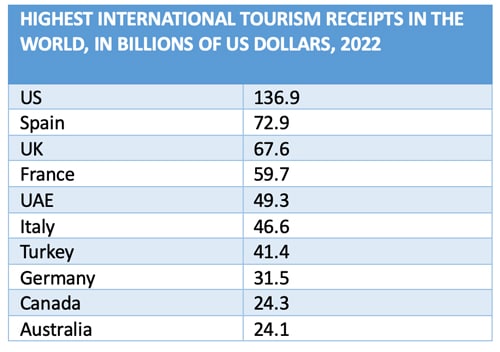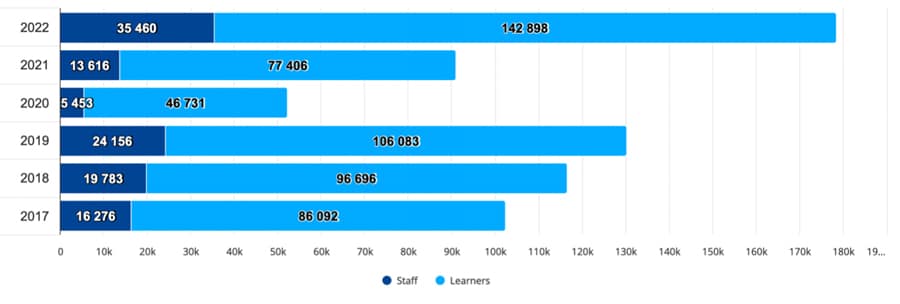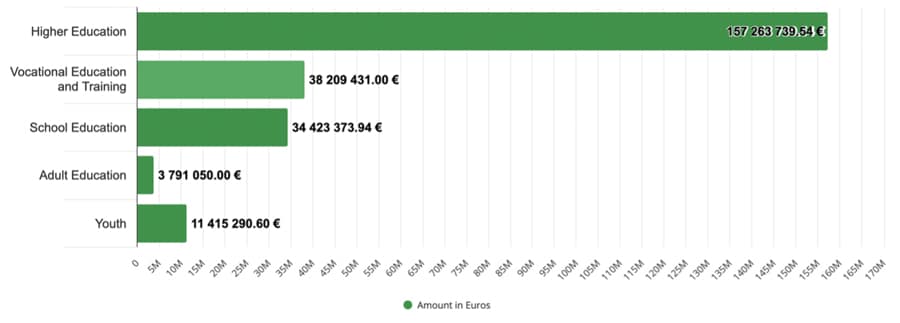New policies, Erasmus+, and booming tourism boost Spain’s international education sector
- The impact of foreign student spending in Spain is significant, and bolstered by the effects of Erasmus+ mobility and the popularity of the Spanish language-training sector
- Spain recorded more tourism revenue in 2023 than in any other year on record
- There are now more opportunities for international students to work in Spain while studying and to seek employment post-graduation
- More Italian, French, and German students have chosen Spain as a study destination in the years post-Brexit
- Spanish educators are being supported in their recruitment efforts in Africa by a government strategy entitled Focus Africa 2023
New government policies in Spain – as well as a changed competitive context in the broader international education landscape – appear to be contributing to Spain’s increasing popularity among foreign students.
Even before the pandemic, the collective value of students studying in Spain’s language courses, undergraduate and graduate courses, and business schools – including those covered by Europe’s mobility programme, Erasmus+ – was estimated at €3.8 billion for the 2018/19 academic year (direct and indirect impacts).
The massive impact of the Spanish language sector
There were more than 100,000 students in Spain’s language programmes in 2022 for a total direct economic impact of €2.1 million – and that’s not including language students’ spending on accommodation, living expenses, transportation, and leisure while in Spain.
Language studies and tourism are very closely linked, and money spent by foreigners in each sector amplifies the collective value of both sectors. This is especially true in Spain, given that the country is one of the world’s top destinations for holidaymakers. Data in the chart below, from Statista, show that Spain is second only to the US when measured in terms of countries with the highest international tourism receipts. FEDELE highlighted the interwoven nature of tourism and language studies in a post on ICEF Monitor last year.

Spain received a record number of tourists in 2023, higher even than before the pandemic. Tourists spent €108 billion last year, a 17% increase over 2019. This figure is expected to rise again in 2024 to €200 billion according to industry body Exceltur.
Erasmus+ sending ever-larger numbers of students to Spain
Another major factor in Spain’s popularity as a study destination is the Erasmus+ mobility programme. Record numbers of Europeans are going to Spain under the Erasmus+ scheme, as shown in the chart below. Erasmus+ students do not have to pay tuition, but they do of course spend money while in Spain in the larger economy.

Most Erasmus+ grants for travel to Spain are given to Europeans entering Spain’s higher education sector, as depicted in the next chart.

In 2021/22, a total of 224,080 international students were in Spanish higher education, with most in degree programmes (170,220) and another 53,860 in shorter-term academic exchanges (Erasmus+).
The top markets for Spain’s universities are shown below.

New policies further fuel Spain’s popularity
In the summer of 2023, the Spanish government extended in-study work rights for full-time international students to 30 hours per week while studying (up from 20 hours previously), and it also introduced an opportunity for students graduating with a Spanish undergraduate degree, master’s degree, or PhD programme to remain in the country for a year to look for work under a job-search visa (estancia por estudios superiores que cesa, para búsqueda de empleo).
Before the new post-study job search visa was introduced, many international students had found it difficult to remain in Spain after their studies to seek employment. They had needed to have a study visa for 3 years to apply for a work permit – leaving a huge proportion of students ineligible because they had studied in shorter programmes such as a master’s degree.
Further easing the ability of international student graduates to work in Spain, it is now much simpler for students to extend their work permit once they have one. When students’ 1-year permit is up for renewal, it can be extended for 4 years in one fell swoop. Previously, the extension had been only 2 years (and then 2 years again if desired) before permit-holders were eligible for permanent residence.
The competitive landscape has changed
Intra-regional mobility in Europe has been greatly affected by Brexit. Because the UK has become more expensive for EU students, those students are considering more destinations in their own region. Expat.com notes that Spain has gained traction in several European countries post-Brexit:
“Spain has also experienced an increase in students from neighboring European countries that speak a Romance language and from Germany. In 2021, the number of new Italian students in Spain increased by 8.8% to around 10,000, while the number of new French students increased by 26.4% to around 7,000. German students increased by 21.9% to about 7,000 new students, too. Spain doesn't offer free higher education to EU nationals, but its tuition fees remain low, around €1,000-2,000 per year.”
There is also potential for the number of non-EU students choosing Spain to increase, as the Spanish government launched a strategy in 2023 to intensify recruitment in Africa.
For additional background, please see:
- ICEF Spanish Education (Madrid, 22–24 May 2024) is a unique opportunity for education providers in Spanish speaking countries to network with ICEF-screened, quality student recruitment agents from around the world
- “Spain to ease visa processes for international students and graduates”
- “Spain moving to expand partnerships and student recruitment in Africa”
- “Spain’s language teaching sector bounces back”
















